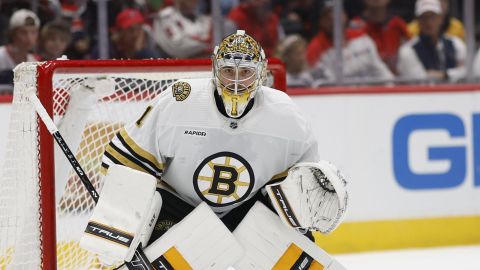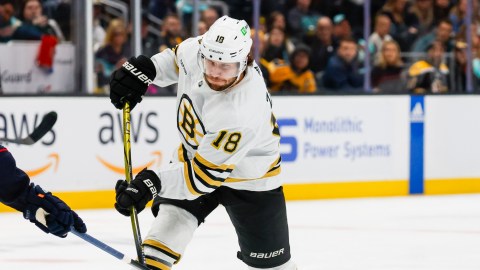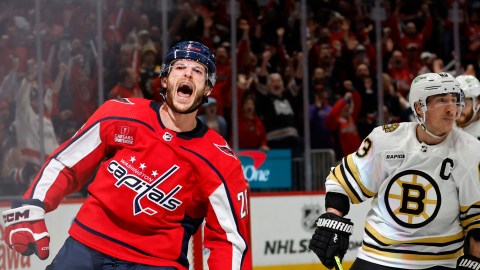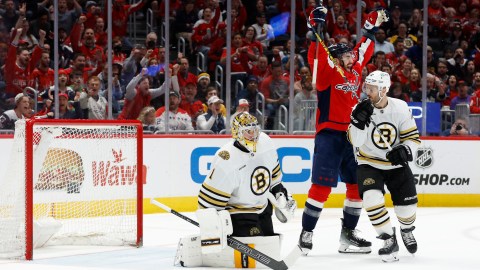Another day, another head shot debate.
Saturday's NHL playoff action produced another nail-biter between the Rangers and Capitals, with Mike Green's late third-period goal the difference in a 3-2 Washington win to even the series.
The game also stirred up more controversy with a questionable hit by Alex Ovechkin on Dan Girardi in the second period. Ovechkin was given a two-minute minor for charging, as he appeared to leave his feet as he made contact.
Almost immediately, arguments raged over whether Ovechkin deserved further punishment from the league, although reports Saturday night had Ovechkin not expected to face a hearing with league disciplinarian Brendan Shanahan despite Ovechkin's prior suspensions for illegal hits.
No surprise there. Ovechkin may not get star treatment from his own coach, with Dale Hunter limiting his ice time in the playoffs, but he is still a star, and that has its privileges when it comes to the league's handling of supplemental discipline.
Ovechkin's hit was far from the worst offense the NHL has seen this postseason. It's debatable whether it would warrant further punishment regardless of the stature of the players involved, but it does highlight the ongoing problems in the game with shots to the head, intentional or otherwise.
Shanahan has been busy this postseason, handing out nine suspensions totaling 41 games and issuing two other fines. Even with Ovechkin unlikely to add to that total, there could be more to come this weekend with Phoenix's Rostislav Klesla scheduled for a hearing on Sunday after boarding Nashville's Matt Halischuk on Friday.
Shanahan has received mixed reviews for his decisions. There are certainly valid concerns over his consistency, with the standard constantly shifting — from a mere $2,500 fine to Shea Weber for slamming Henrik Zetterberg's head into the glass at end of a game to a 25-game ban for Raffi Torres' vicious leaping hit that left Marian Hossa concussed. Torres is now appealing that suspension, and the inconsistency of Shanahan's punishments could give Torres the basis for a case.
But while the messages have been mixed at times, it is clear the league is trying to curtail the epidemic of dangerous hits and the debilitating concussions they cause.
No team knows more about the devastating effect of head injuries than the Bruins, who have seen Marc Savard's career likely ended, Patrice Bergeron lose nearly a full season and Nathan Horton miss the second half of this past season and the playoffs all as a result of concussions.
Bruins president Cam Neely played the game as physically as anyone in his playing days and is concerned with losing the physicality of the game, but considering the toll his team has already paid from dangerous hits, he understandably wants to get the dirty hits out of the game. But Neely sees the responsibility falling on the players as well as the league.
"That's the fine line," Neely said Thursday after his end-of-season news conference. "You want to have the contact in the sport. I think a lot of people, a lot of our fans, certainly love the contact in the sport. The players have to do as much, too, maybe even more so than what the league is trying to do as far as making sure they're avoiding head shots, hitting a guy late and having the head a principal point of contact. It's a very difficult job to police that from the league's perspective, but I think they're trying their best. You saw the suspension they gave Torres, so that's maybe a step in a direction of saying, 'Hey guys, enough is enough.' "
But just policing the dirty hits isn't enough. Even many legal hits are contributing to the rise of head injuries in today's game. The speed of the game and the ever-increasing size of the players will make some injuries inevitable. But Neely, like many in hockey, believes some of those concussions could be avoided with better equipment. The hard plastic elbow and shoulder pads in use today may offer greater protection to the wearer, but they do little to protect the players on the other side of those collisions.
"Personally, I'd rather have a player with a separated shoulder than someone with a concussion," Neely said. "I don't know why it's that difficult to look at the equipment and say, we really need to do something with the shoulder pads, the elbow pads. To me it seems like a pretty easy, I don't want to say solution to what's going on, but at least take a hard look at it and say, 'If we really reduce this stuff we might have some other injuries, but not the severity of the injuries we're having now.'
"The players really have to get involved, too," Neely continued. "The league can do as much as they want and they can with suspensions and the like, but the players also have to take a hard look at how they're approaching the game themselves. I know it's a fast game. I know it's a competitive game. But they have to be as smart as they possibly can on the ice. But the equipment is something I know they've talked about. I know they do look at it, but they should really take a hard look at it and get a better understanding. Is this part of the problem?"
As shown by the ongoing debates arising almost every night from questionable hits, the problem of head injuries in hockey is a complex one. There isn't an easy solution to all of the issues, but safer equipment would be a good first step. Players actually caring about each other's safety would be an ever greater leap forward.
Have a question for Douglas Flynn? Send it to him via Twitter at @douglasflynn or send it here. He will pick a few questions to answer every week for his mailbag.



